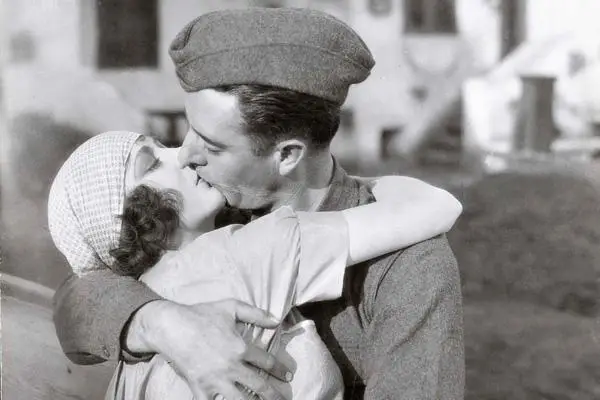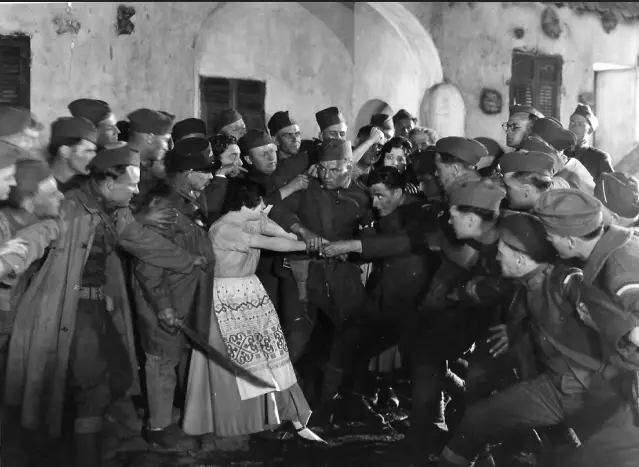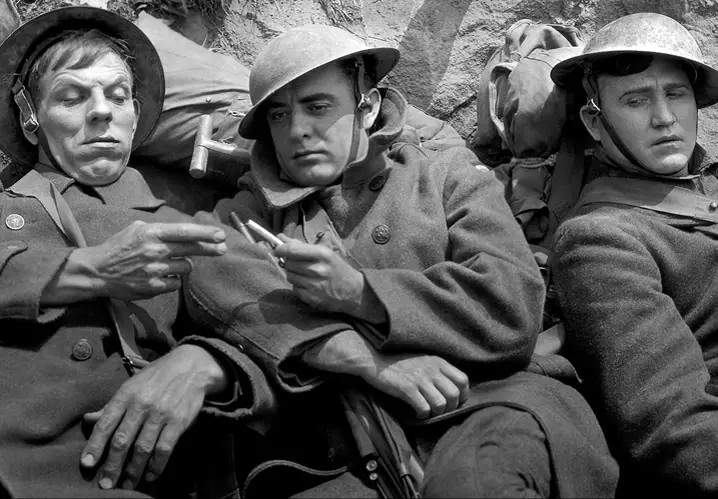
Director: King Vidor
Producer: Irving Thalberg (MGM)
Writers: Laurence Stallings (play), Harry Behn and Joseph Farnham (screenplay)
Photography: John Arnold
Music: William Axt, Maurice Baron, David Mendoza
Cast: John Gilbert, Renee Adoree, Hobart Bosworth, Claire McDowell, Claire Adams, Robert Ober, Tom O’Brien, Karl Dane, Rosita Marstini, George Beranger, Frank Currier
![]()
Introduction
The debate over history’s greatest silent film no doubt includes Griffith’s Intolerance (1915), Eisenstein’s Battleship Potemkin (1925), Keaton’s The General (1927), Lang’s Metropolis (1927), Murnau’s Sunrise (1927) and Chaplin’s City Lights (1931). But in sheer box office dollars, King Vidor reigns supreme with The Big Parade, the highest grossing silent movie ever at $22 million, the equivalent of $285 million today.
It was this success that enabled Vidor’s most personal work, The Crowd, which remains his undisputed masterpiece. The two are tied together in movie history, the art film that got its chance off the success of the blockbuster, both filmed at MGM under the flexibility of producer Irving Thalberg, edited by Hugh Wynn, starring young leading men who tragically died within the next decade, and directed by the man who fittingly went by the name “King.”

![]()
Plot Summary
Based on the Broadway hit What Price Glory? by Laurence Stallings, The Big Parade took viewers to the battlefields of World War I, opening with the pomp and circumstance of new enlistees headed off for war. The story follows a rich businessman’s son, Jim Apperson (John Gilbert), and his two buddies, lanky Slim (Karl Dane) and chubby Bull (Tom O’Brien), who decide to join up together for WWI.
Bidding farewell to his fiancee, Justyn (Claire Adams), Jim heads to France, where he’s struck by the Godfather “thunderbolt” in a beautiful French woman named Melisande (Renee Adoree). Despite a language barrier, the two strike up a passionate relationship before Jim is sent into battle, where he is greatly injured and has to watch Slim and Bull gunned down by enemy fire.
After the war, Jim returns home with his leg amputated only to find his fiancee with another man. Distraught, he returns to France in search of his lost French love, embracing her in an unrealistic but sentimentally satisfying conclusion.
![]()
Epic Romance
This is how epic war romances should be done. Perhaps it wouldn’t have hurt Michael Bay to see this before Pearl Harbor (2001). Of course, a two-and-a-half hour silent film is a challenge for most modern audiences to take on. But if you can weather that storm, you will see that this one has it all — action, romance, drama, even physical comedy like in the French farmhouse scene. Vidor rarely attempted full comedy, but when he did (i.e. his three Marion Davies pictures), he excelled. Perhaps he suffered from a Sullivan’s Travels complex, favoring social commentary over other forms.
While The Big Parade features an almost pacifistic take on war — the war-weary Jim is a clear contrast to his nationalist father character — the film doesn’t push the issue too hard, devoting most of its time to the lighthearted romance between Jim and Melisande.
Vidor’s innate sense of humor is revealed through this relationship, kickstarting Jim’s courting with the dialogue card: “Jim detailed himself to some more skirt duty.” The romantic exchanges are unforgettable, be it their initial meeting with Jim inside a barrel, or later on as Jim teaches her how to chew gum.

The actress, Renee Adoree, is adorable enough that actor John Gilbert would be smitten, but it’s a shame Gilbert could never quite cross over into talkies, cast alongside Greta Garbo in the classic Queen Christina (1933) before dying in 1936. Heart failure was the official cause, though Vidor postulated that it was “frustration” over his inability to make it in talking pictures. In this light, The Big Parade‘s most famous image is all the more touching: Gilbert waving goodbye to Adoree as his army truck pulls away; her holding onto the back of the truck, refusing to let him go, but eventually falling.
I smile each time I watch Gilbert tossing her his watch, his neck chain and, with nothing else left to toss, his shoe. The shot of Adoree sitting alone in the middle of a dirt road, clutching that shoe to her chest, remains one of the most iconic images of the entire silent era.

![]()
Pioneering War Flick
Such a relationship is a powerful set-up for the war, which dominates the latter part of the picture. The Big Parade is widely considered the first realistic movie depiction of war, with Vidor dubbing it “an honest war picture.” (A) This is partly due to the film’s narrative approach, taking a personal look from one soldier’s point of view, rather than present the war from a broader, strategic standpoint. This was a groundbreaking idea at the time, emulated by most every war picture to date, including All Quiet on the Western Front (1930), which won Best Picture just five years later.

It was also partly due to the visual presentation, with cinematographers John Arnold and Charles Van Enger benefiting from the photographic effects of Max Fabian, who would go on to work on San Francisco (1936), Mrs. Miniver (1942), Forbidden Planet (1956) and The Wizard of Oz (1939), which Vidor took over when director Victor Fleming left to save David O. Selznick’s baby, Gone With the Wind (1939). Fabian’s effects build a heartbreaking montage of wounded warrior grief, as Jim’s mother recalls superimposed memories of his childhood, back before he lost a leg in battle.
The most impressive war scene comes as Jim’s company marches through a wooded thicket, as enemy snipers pick them off one-by-one from the trees. The sequence plays out like a brutal ballet, a poetry of peppered bodies, each person falling to the clunk of a piano key. Of course, this exact music wasn’t in the film upon its release — back then, screenings were accompanied by a live orchestra with hundreds of musicians. The music heard in today’s version is a worthy 1981 recreation by Carl Davis and the English Chamber Orchestra, playing such catchy tunes as George M. Cohan’s “Over There” (see Cagney in Yankee Doodle Dandy) and the recurring theme of “We’re in the Army Now,” its lyrics flashing up on screen in title cards. Vidor has said he directed with music in mind, even playing it on the set, and in this particular sniper sequence, he had the men march to the cadence of a metronome, which could then be matched up by the live orchestra in the movie theater pit.
![]()
Legacy
It’s impossible to imagine what audiences must have felt at these grand events of moving pictures and live music, but it’s wonderful to try. The film was a hit, both critically and commercially, to which Vidor told The Celluloid Muse years later, “There were no Academy Awards at the time. But, had we had them, I probably would have swept the whole field. It was a tremendous triumph.” (A)
Vidor was correct to say the film put him “on the map,” leading to a long-term deal with MGM that produced his masterpiece The Crowd (1928) three years later. Even decades after his death, the legacy of Vidor — and his epic silent war flick — live on in the minds of other filmmakers. Frank Darabont, who directed popular favorites like The Shawshank Redemption (1994), The Green Mile (1999) and TV’s The Walking Dead (2010), gave a nod to Vidor in his salute to classic movies, The Majestic (2001), as Jim Carrey walks in on Martin Landau screening The Big Parade. Landau says the family loved it so much, he bought the print.
![]()
Citations:
CITE A: Turner Classic Movies, Felicia Feister’s review of Our Daily Bread (1934)
